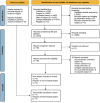Virtual reality therapy in managing cancer pain in middle-aged and elderly: a systematic review and meta-analysis
- PMID: 39686987
- PMCID: PMC11648695
- DOI: 10.7717/peerj.18701
Virtual reality therapy in managing cancer pain in middle-aged and elderly: a systematic review and meta-analysis
Abstract
Background: Virtual reality technology has been proposed to rehabilitate cancer patients. This study aimed to summarize the effectiveness of virtual reality (VR)--based therapies for pain management in middle-aged and elderly cancer patients.
Methods: This meta-analysis was registered in PROSPERO (CRD42023400432). We searched the randomized controlled trials (RCTs) in PubMed, Scopus, the Cochrane Library, Web of Science, and Embase, conducted from construction until November 1, 2024. The study examined the effects of VR treatment on pain levels in middle-aged and elderly cancer patients using RCTs as primary or secondary outcome measures. Articles were evaluated for eligibility according to predetermined criteria, and each of the three researchers independently collected the data. The researchers used the heterogeneous selection effects model to calculate the mean effect sizes.
Results: This meta-analysis included seven RCTs involving 476 patients. The meta-analysis confirmed the significant effect of VR therapy on the management of pain, anxiety, and depression in the middle-aged and elderly cancer population.
Conclusions: Our research shows that VR could be a significant device for cancer pain management in the middle-aged and elderly and that VR scene therapy may be more effective. Nevertheless, it is essential to use caution when interpreting the findings since the number of research included is small.
Keywords: Cancer pain; Cancer rehabilitation; Elderly patients; Meta-analysis; Virtual reality.
© 2024 Chen et al.
Conflict of interest statement
The authors report no other conflicts of interest in this work.
Figures








Similar articles
-
Using Virtual Reality Exposure Therapy in Pain Management: A Systematic Review and Meta-Analysis of Randomized Controlled Trials.Value Health. 2022 Feb;25(2):288-301. doi: 10.1016/j.jval.2021.04.1285. Epub 2021 Oct 8. Value Health. 2022. PMID: 35094802
-
The Effect of Virtual Reality Application on Pain and Anxiety During Episiotomy Repair: A Systematic Review and Meta-Analysis of Randomized Controlled Trials.Int Urogynecol J. 2024 Oct;35(10):1943-1953. doi: 10.1007/s00192-024-05867-4. Epub 2024 Jul 23. Int Urogynecol J. 2024. PMID: 39042152
-
Effects of virtual reality-based rehabilitation on cognitive function and mood in multiple sclerosis: A systematic review and meta-analysis of randomized controlled trials.Mult Scler Relat Disord. 2024 Jul;87:105643. doi: 10.1016/j.msard.2024.105643. Epub 2024 May 9. Mult Scler Relat Disord. 2024. PMID: 38735202
-
Effectiveness of Virtual Reality for Pain Management in Musculoskeletal Disorders Across Anatomical Regions: A Systematic Review and Meta-Analysis.Musculoskeletal Care. 2025 Mar;23(1):e70041. doi: 10.1002/msc.70041. Musculoskeletal Care. 2025. PMID: 39754331 Free PMC article.
-
The Effectiveness of Virtual Reality in Managing Acute Pain and Anxiety for Medical Inpatients: Systematic Review.J Med Internet Res. 2020 Nov 2;22(11):e17980. doi: 10.2196/17980. J Med Internet Res. 2020. PMID: 33136055 Free PMC article.
Cited by
-
Effect of virtual reality on pain in oncology patients: A systematic review.Medicine (Baltimore). 2025 Aug 8;104(32):e43487. doi: 10.1097/MD.0000000000043487. Medicine (Baltimore). 2025. PMID: 40797462 Free PMC article.
References
Publication types
MeSH terms
LinkOut - more resources
Full Text Sources
Medical

